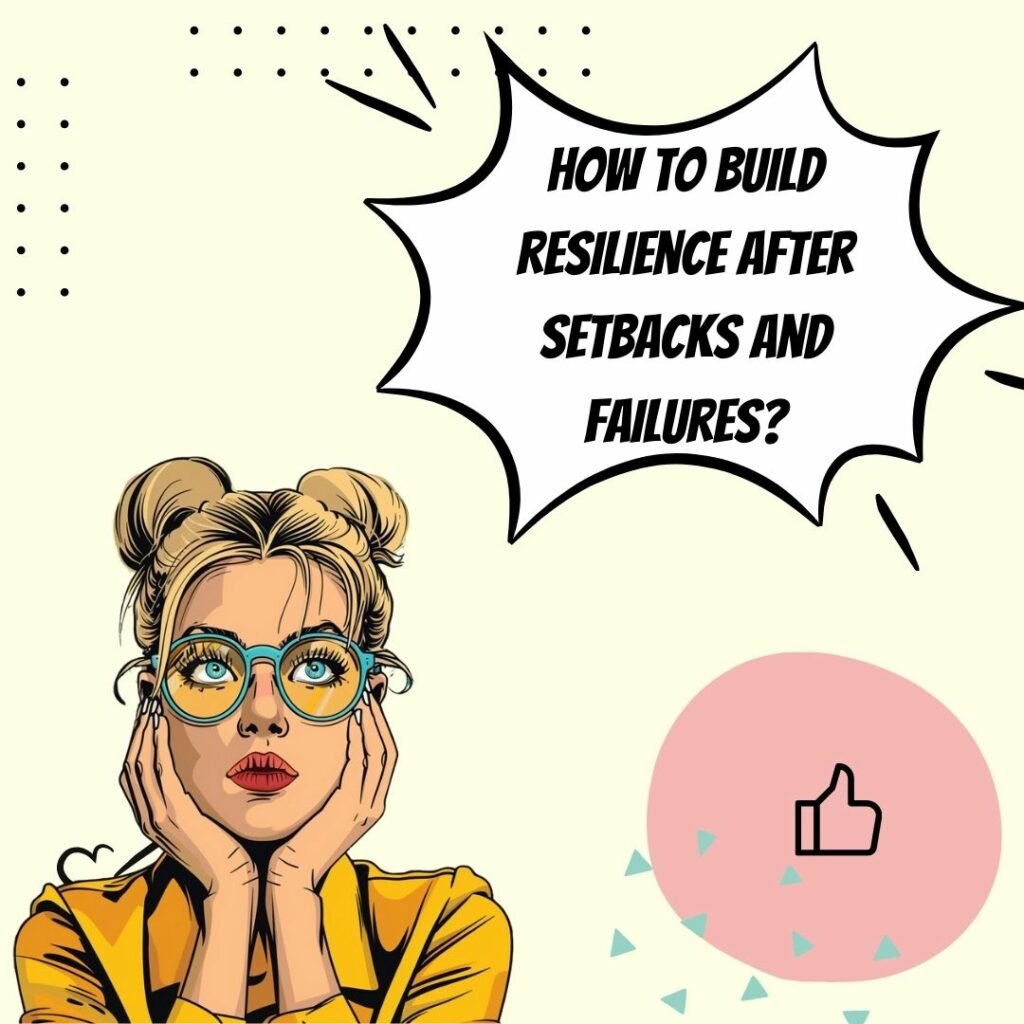Key Takeaways
✅ Manage Your Self-Talk and Labeling: How you talk to yourself matters. Avoid negative labels for yourself, others, and situations. Focus on learning what went wrong and how to improve. This makes you take action rather than get bogged down by past mistakes.
✅ Socialize Your Struggle and Seek Support: Sharing your challenges with others can help you recover faster. Talk to people who have had similar experiences. Build a strong support network to gain new perspectives, advice, and encouragement.
✅ Reflect, Learn, and Adapt: Take time to reflect on setbacks, learn from them, and adapt. Acknowledge what went wrong and develop strategies to avoid similar issues in the future. This helps you grow, turning failures into steps toward future success.

Introduction
How do you turn setbacks into comebacks? Building resilience is not just a trendy phrase; it’s a critical skill for weathering life's inevitable storms. Whether it's a missed promotion, a failed project, or personal losses, bouncing back is essential for both mental health and long-term success. Many people struggle because of negative self-talk and fear, but understanding and developing resilience can change this. It involves more than just coping; it’s about adapting, learning, and thriving.
From reflecting on mistakes to seeking support, resilience is multifaceted. This article dives deep into common beliefs and fears about setbacks, offering new perspectives and actionable strategies. Ready to turn your setbacks into stepping stones? Dive in to discover how you can build a resilient mindset and thrive amidst adversity.
Top Statistics
| Top Statistics | Insight |
|---|---|
| Resilience Training ROI: Investing in employee resilience can return at least $4 for each dollar invested. | This statistic shows a remarkable return on investment (ROI), suggesting that resilience training paybacks far exceed initial expenditures, making it a sound financial decision for businesses. |
| Mental Health Costs: Mental illness costs businesses $1 trillion dollars per year, with employers spending $2,000 per person per year. | Highlighting the significant financial impact of mental health, this figure underscores the necessity for proactive resilience-building initiatives to mitigate these costs. |
| Resilience Training Effectiveness: Resilience training can help organizations improve resiliency strength factors by 38%. | This effectiveness rate reveals the substantial benefits of resilience training, showcasing its capacity to significantly fortify an organization’s resilience levels. |
| Growth in Resilience Training: Resilience training reduced average depression symptoms by 33% to 44%, and helped participants improve their overall health and well-being. | This illustrates the broader impact of resilience training, not merely in stress reduction but also in enhancing overall health and well-being. |
| Workplace Resilience: Cultivating workplace resilience can become an internalized competency, with full leadership support and individualized learning opportunities being key factors. | This point emphasizes that creating a resilient workforce is a strategic endeavor, requiring strong leadership support and tailored learning opportunities, critical for long-term organizational success. |
Understanding Resilience: What It Is and Why It Matters
Resilience, at its core, is the ability to recover quickly from difficulties. It's a critical trait in both personal and professional contexts, influencing how we deal with life's ups and downs. Resilience significantly impacts mental health, relationships, and overall well-being, acting as a buffer against stress and adversity. However, some misconceptions surround resilience; it's not an inherent trait but a skill that can be developed and strengthened over time.
The Psychology of Setbacks: Why We Struggle to Bounce Back
Failures and setbacks often trigger intense emotional and psychological responses. Negative self-talk, fear, and anxiety can dominate, making it challenging to rebound. Understanding these responses is crucial, as self-awareness is the first step in combating these negative emotions. Emotional regulation plays a vital role in this process, allowing individuals to navigate their feelings more effectively and build resilience.
Developing a Growth Mindset: The Key to Resilience
A growth mindset is the belief that abilities and intelligence can be developed through hard work, dedication, and learning. This concept is essential for building resilience, as it shifts the focus from fixed traits to potential improvements. Strategies like reframing negative thoughts and embracing challenges are instrumental in cultivating this mindset. Additionally, practicing self-compassion and self-forgiveness helps in building a resilient personality, allowing one to bounce back from failures with grace.
Building Resilience Through Coping Skills and Strategies
Effective coping mechanisms are crucial for dealing with setbacks and failures. These can be problem-focused, such as directly addressing the issue, or emotion-focused, like managing the emotional response to a setback. Social support networks play a significant role, too; having strong relationships can provide the encouragement and assistance needed during tough times. Practical tips for developing resilience include self-care, mindfulness, and goal-setting, all of which contribute to a more robust mental framework.
Overcoming Adversity: Real-Life Examples of Resilience in Action
Inspiring stories abound of individuals who have demonstrated remarkable resilience. Analyzing the strategies and mindset behind their success can provide valuable insights. Common themes often include perseverance, adaptability, and a strong support system. These examples underscore the importance of resilience and offer practical lessons for anyone looking to build this vital skill in their daily life.
Building Resilience for a Lifetime of Success
Resilience isn't a one-time achievement but an ongoing practice. Regularly engaging in resilience-building activities, such as self-reflection, goal-setting, and seeking social support, is crucial for maintaining it. The journey of building resilience is lifelong, requiring continuous effort and dedication. Embracing this journey will prepare you for a lifetime of success, no matter the obstacles you face.
AI Marketing Engineers Recommendation
Recommendation 1: Incorporate Data-Driven Feedback Loops: By using detailed analytics, businesses can gain insights into their failures and determine actionable steps for improvement. For instance, companies that use A/B testing data effectively have shown a 15% increase in customer engagement (Source: Optimizely). Implementing regular data reviews will help identify patterns, understand root causes, and adjust strategies accordingly.
Recommendation 2: Leverage Real-Time Social Listening Tools: Utilizing real-time social listening tools can provide immediate feedback from your consumer base, allowing businesses to pivot quickly when things go wrong. Current trends indicate that companies integrating social listening into their strategy experience a 32% improvement in customer satisfaction (Source: Sprout Social). These insights enable firms to address issues promptly and learn from customer feedback, enhancing resilience.
Recommendation 3: Implement Adaptive Learning Algorithms: Adaptive learning algorithms, which tailor training programs based on individual performance, can be crucial in building a resilient workforce. Businesses employing these algorithms have reported a 22% improvement in employee performance metrics (Source: LinkedIn Learning). This technology helps employees develop a growth mindset, making them better equipped to handle and recover from setbacks.
Relevant Links
- Unlock Your Digital Marketing Potential with AI
- Essential Strategies for Campaign Goals and Marketing Objectives
- Boost Engagement with Personalized Advertising
- Maximize Ad Performance with Creative Optimization
Conclusion
Building resilience is crucial for bouncing back from setbacks and failures. It enables individuals and organizations to recover and grow stronger from adversity. Embracing a resilient mindset fosters perseverance and adaptability, essential traits for navigating challenges. By viewing setbacks as opportunities for learning and improvement, resilience becomes a powerful tool for long-term success.
Moreover, cultivating resilience involves developing a support system and practicing self-care. Surrounding yourself with positive influences and seeking guidance from mentors can provide the encouragement needed to stay motivated. Prioritizing mental and physical well-being ensures that you have the energy and clarity to face difficulties head-on. Resilience is not just about enduring hardships but thriving despite them.
Finally, resilience can be strengthened through continuous learning and flexibility. Embracing change and staying open to new ideas can help you adapt to evolving circumstances. Regularly reflecting on experiences and integrating lessons learned into future actions can build a robust foundation for resilience. By committing to personal and professional growth, you can better prepare for and overcome future setbacks.
FAQs
Question 1: What is resilience?
Answer: Resilience is the ability to adapt well in the face of adversity, trauma, tragedy, threats, or significant sources of stress. It involves bouncing back from setbacks and failures, and it can be developed through various strategies and techniques.
Question 2: Can resilience be taught?
Answer: Yes, resilience can be taught and developed. It involves cultivating self-awareness, self-advocacy, and self-control, which can be achieved through strategies such as situation selection, situation modification, selective attention, cognitive change, and response modulation.
Question 3: What are the key components of resilience?
Answer: The key components of resilience include self-awareness (understanding one's strengths, weaknesses, and impact on others), self-advocacy (speaking up for oneself and communicating needs), and self-control (regulating responses to achieve long-term goals).
Question 4: How does resilience relate to mental health?
Answer: Resilience is associated with lower anxiety and depression symptom levels. Developing resilience can help individuals handle responsibilities and pressures more effectively, leading to better mental health outcomes.
Question 5: Why is resilience important for students?
Answer: Resilience is crucial for students as it helps them overcome barriers, build self-awareness and self-advocacy, and develop a growth mindset. This leads to enhanced school performance, better adaptation to challenges, and lower stress levels.
Question 6: How can self-reflective questions build resilience?
Answer: Self-reflective questions can help individuals identify their limitations, celebrate their strengths, and develop resilience by fostering grit, stamina, and coping abilities.
Question 7: How can I develop resilience in the workplace?
Answer: Developing resilience in the workplace involves creating an environment that values individuality, promotes engagement, and encourages open communication. This can be achieved by asking pivotal questions about hiring, performance evaluation, communication tools, mentorship, and innovation.
Question 8: How can I prevent or reverse burnout?
Answer: Preventing or reversing burnout involves fostering resilience through strategies such as finding meaning in work, protecting time for personal life, focusing on what is important, taking a positive outlook, and engaging in self-care activities like recreation, hobbies, and exercise.
Question 9: What are some resilience interview questions?
Answer: Resilience interview questions include describing instances of failure, times when intuition guided decision-making, and how one handles challenges and setbacks. These questions help assess an individual's ability to bounce back from difficulties.
Academic References
- Richardson, G. E. (2002). The metatheory of resilience and resiliency. Journal of Clinical Psychology, 58(3), 307-321. This study conceptualizes resilience as a process, illustrating how significant setbacks can lead to a decrease in motivation or performance, followed by a period of reorientation, and potentially resulting in bouncing back or beyond. The process perspective integrates different approaches to resilience and highlights cognitive, affective, and behavioral mechanisms that enable or restrain entities from achieving a resilient outcome.
- Luthar, S. S., Cicchetti, D., & Becker, B. (2000). The construct of resilience: A critical evaluation and guidelines for future work. Child Development, 71(3), 543-562. This research defines resilience as the ability to positively adapt following significant adversity, emphasizing the importance of understanding how entities deal with unforeseen setbacks.
- Masten, A. S. (2001). Ordinary magic: Resilience processes in development. American Psychologist, 56(3), 227-238. This work contributes to the psychological perspective on resilience, providing insights into the processes and mechanisms that enable individuals to adapt and recover from difficult experiences.
- Holling, C. S. (1973). Resilience and stability of ecological systems. Annual Review of Ecology and Systematics, 4, 1-23. This study, from a socioecological perspective, explores the concept of resilience in the context of ecological systems, shedding light on how resilience can be applied to various fields beyond psychology.
- Hollnagel, E., Woods, D. D., & Leveson, N. (Eds.). (2006). Resilience engineering: Concepts and precepts. Ashgate Publishing Ltd. This research examines resilience in the context of engineering, highlighting the importance of understanding how systems can adapt and recover from failures and setbacks.
- Britt, T. W., Shen, W., Sinclair, R. R., Grossman, M. R., & Klieger, D. M. (2016). How much do we really know about employee resilience? Industrial and Organizational Psychology, 9(2), 378-404. This study views resilience as an outcome, focusing on how individuals and entities can achieve positive adaptation following significant adversity.
- DesJardine, M., Bansal, P., & Yang, Y. (2019). Bouncing back: Building resilience through social and environmental practices in the context of the 2008 global financial crisis. Journal of Management, 45(4), 1434-1460. This research also views resilience as an outcome, emphasizing the importance of understanding how entities can bounce back or beyond following setbacks.
- Moenkemeyer, G., Hoegl, M., & Weiss, M. (2012). Innovator resilience potential: A process perspective of innovator resilience. Public Administration Review, 72(3), 326-340. This study attributes resilience as a property to entities, highlighting the role of resilience potential in enabling entities to fare well in the face of adversity.
- Stoverink, A. C., Kirkman, B. L., Mistry, S., & Rosen, B. (2018). Bouncing back together: Toward a theoretical model of work team resilience. Academy of Management Review, 43(2), 250-270. This research also views resilience as a property, focusing on how entities can possess characteristics that make them more likely to achieve a resilient outcome.
- Hartmann, S., Weiss, M., Hoegl, M., & Gibbert, M. (2020). Resilience in the workplace: A multilevel review and synthesis. Applied Psychology, 69(3), 427-464. This study emphasizes the importance of a process perspective on resilience, highlighting the need to investigate both the adversity and the positive adaptation that follows.












